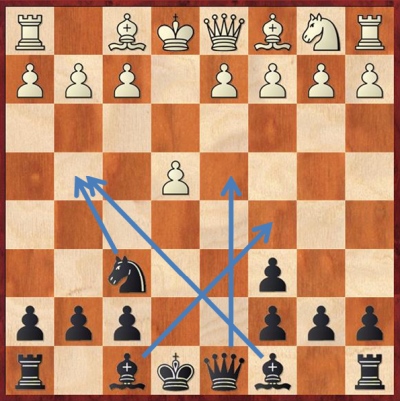Back in January 2021, an in-depth article on the Stunning Stafford Gambit was produced, where I tried to present a strong and persuasive case for playing it, its main features being …
- It’s exciting!
- It’s adventurous!
- It’s daring!
- It’s full of traps!
- It’s unsound! This can often work in Black’s favour as the pressure is all on White.
Please refer to the article by clicking on the following link … Bulletin No.45 – The Stunning Stafford Gambit
Nine months on, given its initial popularity yet obvious shortcomings, many believed that ‘easy refutations’ would have by now been found and fully understood by players of all standards and styles. Therefore, it was expected that this outrageous gambit would end up as one of those ‘fly by night flash in the pan’ openings destined for the ‘scrap heap’, and never to be seen ever again, except from a few dedicated diehards of which I must be one!
So is the gambit busted?
The mere fact this follow up bulletin has been written suggests there is still life in this scandalous opening with lots of venom awaiting an unsuspecting opponent, which is great news for all Stafford Gambiteers.
The traps and refutation lines will not be covered again as they have been well documented in the previous article noted above (and many more ‘refutation lines’ have been found since!). However, I would like to cover the following in this article as a follow-up:
- What are the Stafford’s overall results?
- Any interesting new lines for Black?
- My personal experience of playing the Stafford since the previous January 2021 bulletin which I hope will continue to excite players of all standards.
- Other Local Games – ‘Find the Winning Move’!
- What if White is not so obliging and does not castle short but castles long instead?
- Summary
1. What are the Stafford’s overall results?
On Lichess, as at 31st August 2021, across all formats and all levels, 4334 games have been played with the Stafford Gambit Accepted (1.e4 e5 2.Nf3 Nf6 3.Nxe5 Nc6 4.Nxc6 dxc6):
- 50% wins for White
- 7% draws
- 43% wins for Black
This suggest, despite its ‘unsoundness’, the results are very respectable and the opening is completely playable in practical terms, particularly at the faster time limit.
The most popular White move is 5.d3 which has been played in 2,514 games (58%) and Black has scored reasonably well at 45%.
The second most popular move, 5.Nc3, which has been played in 1,185 games (27%), and Black has scored above average at 50%.
2. Any Interesting New Lines for Black?
The Stafford Gambit relies a lot on cunning traps and most of these are now well known but one new move for Black has recently appeared as a possible antidote to one of the ‘refutation lines’ for White. This could be worth exploring further but comes with a massive public health warning (as most Stafford lines do)! This follows Refutation No.4 in the previous article https://www.dorsetchess.co.uk/stafford-gambit/ i.e 1.e4 e5 2.Nf3 Nf6 3.Nxe5 Nc6 4.Nxc6 dxc6 5.Nc3 Bc5 6.h3 but instead of the recommended 6…Be6 or 6…h5, Black can now try 6…g5?! (a move Eric Rosen found interesting).
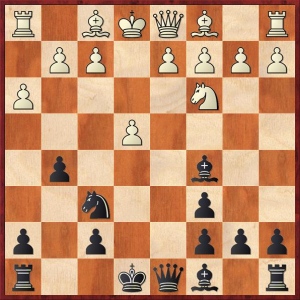
This works well after a natural move like 7.Be2? Qd4 8.0-0 g4! when Black can have lots of fun (please see https://www.youtube.com/watch?v=LvPxdsFH2V8 posted in August 2021 which fully demonstrates this) but why play 7.Be2? After 7.d3! Rg8 8.e5 Nd5 9.Ne4 I am not sure Black is having any fun here and, unfortunately, it is just as easy for White to find 7.d3 as it is to play 7.Be2, so maybe this is one cavalry charge too many!
3. My ‘Stafford Gambit Accepted’ results since January 2021
As at 31st August, I have been very fortunate in winning all 12 of my games (with an unmerited 2500 performance – my true playing strength is much nearer 2100), but in many ways it does continue to show that the gambit is not easy to play against. Whereas the White players may know some of the theory and indeed be aware they should be winning, it can be difficult to demonstrate this, particularly in speed chess games. In many of the ‘safe’ White lines Black can still generate good compensation and enjoy lots of fun for the sacrificed pawn. Furthermore, if Black knows what s/he is doing (and more to the point, White doesn’t!) then there are still great opportunities for swashbuckling victories.
Here are my two favourite wins with sincere apologies to both opponents. They are very similar and in the first game I was lucky to have caught out Roland Bezuidenhout in a very well disguised yet stunning opening trap.
Although I won the second, I hasten to add that David Pye has a substantial positive score against me on Lichess. However, this win (and a later one in the Find the Winning Move section) perhaps show the strength of the Stafford Gambit on a practical level.
Roland Bezuidenhout (2503) v Martin Simons (2203) – Lichess – Wessex All Stars Tournament 2021
1.e4 e5 2.Nf3 Nf6 3.Nxe5 Nc6 4.Nxc6 dxc6 5.Nc3 Bc5 So what will my high ranking opponent play? 6.Be2 h5 7.h3? This natural looking move is surprisingly weak. 7…Qd4! forcing White to defend the f2 pawn and encouraging White’s next move. 8.O-O Ng4! This unexpected move is a common trick in the Stafford. 9.hxg4 hxg4 10.g3 Qe5 11.Kg2
Key Moment: White is a piece ahead and seemingly has everything under control as Qh5 can be comfortably answered with Rh1.
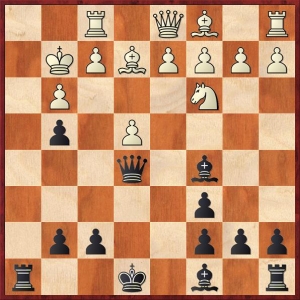
However …
11…Bxf2!! It is not surprising my much stronger but unprepared opponent had missed this incredible move as it is so difficult to spot (mainly because the bishop can be taken twice) but why is it winning?
12.Kxf2 12. Rxf2 is the natural move but then after 12…Qh5 White has no Rh1 move and there is no decent other defence to Qh3+ or Qh2+ followed by mate. If 13.Rf4 Qh2+ 14.Kf1 Qxg3 winning.
12…Rh2+ Despite being 2 pieces up White’s king is being hunted down and as there is no retreat, it is being forced out of its bunker without any defensive cover.
13.Ke3 If 13.Ke1 then 13…Qxg3+ with mate next move. Please compare with the 2nd game below. If 13.Kg1 then 13…Qxg3+ mate.
13…Qxg3+ 14.Kd4 Qd6+ 14…Be6 may be even stronger but the move played is strong too.
15.Nd5 cxd5 16.Bxg4 c5+ 17.Kc3 d4+ 18.Kd3 b5 19.b3 c4+ 20.bxc4 bxc4+ 21.Kxc4 Ba6+ 22.Kb3 Rb8+ 0-1
It’s mate in 1
David Pye (2327) v Martin Simons (2051) – Lichess 2021 – Wessex All Stars Tournament 2021
1.e4 e5 2.Nf3 Nf6 3.Nxe5 Nc6 4.Nxc6 dxc6 5.d3 Bc5 6.Be2 a recommended refutation. 6…h5 7.h3 Not given in the first article on the Stafford https://www.dorsetchess.co.uk/stafford-gambit/ but Black’s next move seems logical. 7…Qd4 8.O-O Ng4 This is similar to the Bezuidenhout game above except White has played 5.d3 rather than 5.Nc3.

Key Moment: 9.Bxg4?
White is acutely aware of the dangers of taking the knight with the pawn which opens the h-file for Black but in this position he can!
e.g. 9.hxg4! hxg4 10.g3! All other moves lose hence the trappiness of this gambit. (e.g. 10.Bf4 Qf6! 11.g3 g5 followed by Qh6) 10…Qe5 11.Kg2. Now 11…Bxf2 does not work 12.Kxf2 Rh2+ 13.Ke1 Qxg3+ 14.Kd2 when the king is quite safe despite what it looks like! Please note the difference with the above Bezuidenhout game when, in that game, 13…Qxg3+ is mating as White’s d-pawn is on d2 and the king is imprisoned!
9…hxg4 10.Nc3
10.hxg4 loses to Qe5 11.Re1 (11.g3 Qxg3#) 11…Qh2+ 12.Kf1 Qh1+ 13.Ke2 Bxg4+ 14.Kd2 Qxg2 winning.
10…Qe5 11.Ne2
11.Qd2 is White’s only chance to play on but after 11…gxh3 12.Qg5 Qxg5 13.Bxg5 hxg2 Black is better.
11…gxh3 12.d4 Qh5?!
As is often the case, it is the placement of the black queen that is key. In many games it can be played to either d4, h4, h5, h7 and f6. I get it slightly wrong in this game. 12… Qf6! ensures there is no glimmer of a defence. After 13.e5 Qf5 14.Ng3 Qh7 15.Qf3 hxg2 16.Qxg2 Bh3 17.Qe4 Bf5! 18.Qh1 Qxh1+ 19.Nxh1 Bxd4 Black is completely winning.
13.Ng3?
13.Nf4! Qh7 when Black is better but not necessarily winning.
13…Qh4 Black is now winning as the attack is too strong.
14.Qf3 hxg2 15.Qxg2 Bh3 16.Qf3 Bg4 17.Qg2 This sets up a nice finish.
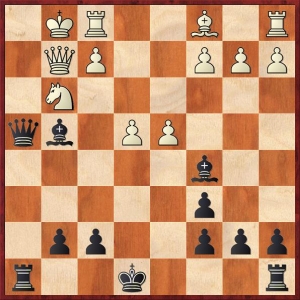
17…Bf3 18.Nf5 (If 18.Qxf3 Qh2 mate) 18…Qh1+ 19.Qxh1 Rxh1# 0-1
4. Other Local Games – Find the Winning Move!
Here I provide 5 extracts from games, including 4 played by local player Alan Dommett who has had similar success with the Stafford Gambit in 2021. All you have to do is Find the Winning Move!
Position 1 – YaserSeif (2064) v Alan Dommett (2134) – Chess24 2021
1.e4 e5 2.Nf3 Nf6 3.Nxe5 Nc6 4.Nxc6 dxc6 5.d3 Bc5 6.Be2 h5 7.Nd2 Ng4 8.O-O White thinks he has everything covered by playing 7.Nd2.
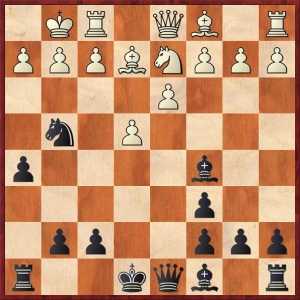
Solution: 8…Qh4! 9.Nf3 Nxf2 10.Rxf2 (White had probably intended 10.Nxh4 but after Nxd1+ 11.Kh1 Nf2+ Black will win 2 pawns or the exchange) 10…Qxf2+. Black is the exchange up and won in 27 moves.
Position 2 – Rustam83 (1785) v Alan Dommett (2103) – Chess24 2021
1.e4 e5 2.Nf3 Nf6 3.Nxe5 Nc6 4.Nxc6 dxc6 5.d3 Bc5 6.Be2 h5 7.O-O Ng4 8.c3 Qd6 9.g3 Qg6 10.d4
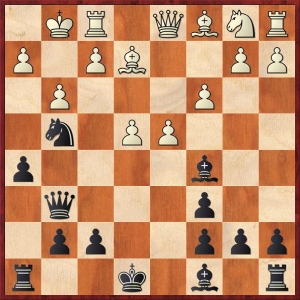
Solution: 10…h4!! 11.h3 (If 11.dxc5 hxg3 12.hxg3 Ne5 with Qh7 to follow winning) 11…Nxf2 12.Rxf2 hxg3 13.Rf4? (13.Rf5 may hold but who would play this?) Rxh3 14.Bg4 Bxg4 15.Qxg4 Qh7 16.Qf3 O-O-O 17.dxc5 Rd1+! 0-1
Position 3 – David Pye (2315) v Martin Simons (2104) – Lichess 2021
1.e4 e5 2. Nf3 Nf6 3.Nxe5 Nc6 4.Nxc6 dxc6 5.d3 Bc5 6.Be2 h5 7.c3 Ng4 8. d4 Qh4 9.Bxg4 Bxg4 10.Qb3 Bb6 11.O-O O-O-O 12.Be3 Be6 13.Qc2 f5 14.Nd2 f4 15.Nf3 Qf6 16.Bd2 g5 17.Ne5 g4 18.Kh1 c5 19.dxc5 Bxc5 20.Nd3 Bb6 21.Nxf4 Bc4 22.Nd5 Bxd5 23.exd5 Rxd5 24.Be3 h4 25.Bxb6 axb6 26.Rad1 Rf5 27.Kg1 h3 28.Qe4 Re5 29.Qxg4+ Kb8 30.Rfe1 Rg5 31.Qd4 Rxg2+ 32.Kf1
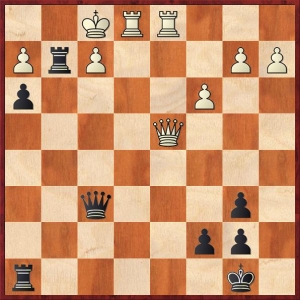
Solution: 32…Qf3! (The rook on h8 is surplus to requirements!) 33.Qxh8+ Ka7 34.Qd4 Rg1+! 35.Kxg1 Qg2 mate.
Position 4 – Wolkof (2092) v Alan Dommett (2140) – Chess24 2021
1.e4 e5 2.Nf3 Nf6 3.Nxe5 Nc6 4.Nxc6 dxc6 5.Nc3 Bc5 6.Be2 h5 7.O-O Ng4 8.h3 Qd4 9.hxg4 hxg4 (So far the same moves as Bezuidenhout v Simons) 10.Bxg4 Qe5 11.Bh3 Bxh3 12.Qf3
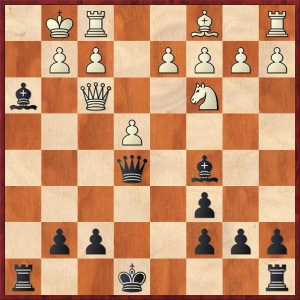
Solution: 12…Bg4! There is no defence to Qh2 mate.
Position 5 – Kabaso Jones (2259) v Alan Dommett (2179) – Chess24 2021
1.e4 e5 2.Nf3 Nf6 3.Nxe5 Nc6 4.Nxc6 dxc6 5.Nc3 Bc5 6.Be2 h5 7.h3 Qd4 8.O-O Ng4 (So far the same moves as Bezuidenhout v Simons and Wolkof v Dommett.) 9.Qe1
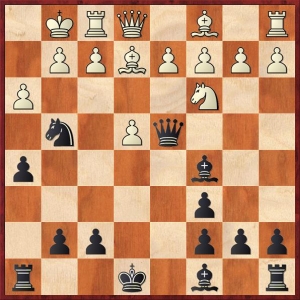
Solution: 9…Qe5! (a common theme) 10.Bxg4 hxg4 11.d4 Bxd4 12.Ne2? (12.Be3 had to be tried) 12…gxh3 13.Bf4 Qh5 14.Ng3 Qh4 15.Be3 (Too late) 15…hxg2 16.Kxg2 Qh3+ 17.Kf3 Bg4+ 18.Kf4 g5+ 19.Kxg5 Rg8+ 20.Kf4 Qh6#
5. What if White is not so obliging and does not castle short but castles long instead?
All the above games involve White castling short so why not castle queenside instead? It would be remiss not to include this possibility in such a follow-up article.
Firstly, from experience, these games are much longer. Indeed, Alan and I call this the ‘Long Stafford’ variation as there are generally no ‘cheap traps’. However, Black can still obtain interesting play …
Plan A: by using the open central lines and swinging his or her pieces from one side of the board to the other, particularly the queen.
Plan B: by throwing the queenside pawns against White’s castled king. It is often surprising how quickly the attack can develop.
Plan C: White is often ‘obliged’ to swap off the e2 bishop for the knight on g4 when Black can recapture with the h-pawn resulting in unrelenting pressure down the h-file.
Here are a three games, all played by Alan, illustrating these themes, the first two are similar. The first is a bit crude but it does illustrate the point.
1.e4 e5 2.Nf3 Nf6 3.Nxe5 Nc6 4.Nxc6 dxc6 5.d3 Bc5 6.Be2 h5 7.Nc3 Ng4 8.Bxg4 hxg4 9.Be3 Bxe3 10.fxe3 Qg5 11.Qe2 Be6 12.O-O-O O-O-O
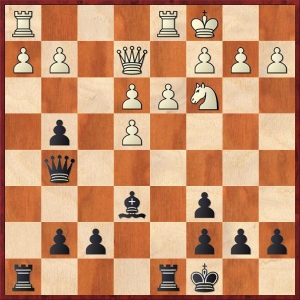
Both sides have castled queenside. We now have a divergence in the two games …
Wallpapper (2046) v Alan Dommett (2054) – Chess24 2021
13.g3 Black can now adopt Plan C above by playing 13…Rh5 with good chances but Alan opts for Plans A and B.
13…Qa5 14.Kb1 b5 15.Qd2? b4 16.Nd5 cxd5 17.exd5 Bxd5 and White resigns!
AEIOU998 (2110) v Alan Dommett (2074) – Chess24 2021
13.Rdf1 f6 14.Qf2 Qa5 (same Plan A as above) 15.Kb1 b5 (same Plan B as above) 16.a3 b4 17.axb4 Qxb4 18.d4 Bc4 19.Rd1 Rh5 20.d5 cxd5 21.Nxd5 Bxd5 22.Rxd5 Rhxd5 23.exd5 Rxd5
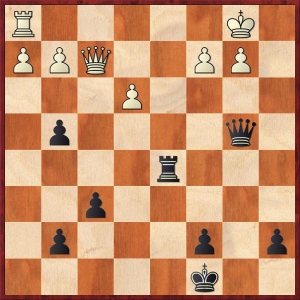
24.h3 Although logical to open up the h-file, White does not really have time to play this move.
24…Rb5 25.b3? Ra5 26.hxg4 Qc3 and mate on a1 is unstoppable. Black won a few moves later.
Dutchplayer7 (1893) v Alan Dommett (2015) – Chess24 – 2021
1.e4 e5 2.Nf3 Nf6 3.Nxe5 Nc6 4.Nxc6 dxc6 5.Nc3 Bc5 6.d3 Ng4 Either this move was missed or White was willing to give back the pawn straight away.
7.Be3 Nxe3 8.fxe3 Bxe3 9.Qe2 Bd4 10.Qd2 O-O 11.O-O-O
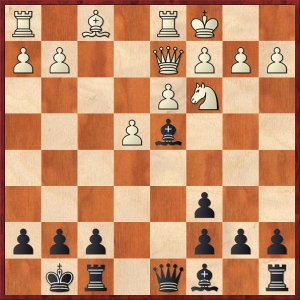
White has castled queenside and thinks he is over the worst but Alan demonstrates the potential for a very quick attack for Black.
11…Qf6! This fixes the knight.
12.Be2 b5 This is Plan B as noted above!
13.Rhf1 Qe5 This attacks h2 and maybe the queen is heading for a5 after b4 – Plan A!
14.Qf4? Understandable to protect h2 and perhaps trade queens but it is a mistake.
14…Bxc3? What is wrong with 14…Qxf4+ 15.Rxf4 Be3+ winning the rook and game? However, Alan still wins quickly!
15.bxc3 Qxc3 16.Bh5 Be6 17.Qd2? Oh dear! Qa1 mate 0-1
6. Summary
It would seem, despite this gambit being theoretically unsound, it still generates excellent practical chances and its results are good so perhaps the Stafford could be here to stay!
With face to face chess returning, who will now dare play it first in our local B&DCL or Dorset Leagues at the more sedate standard playing time control?
It could be you!
Martin Simons – October 2021


